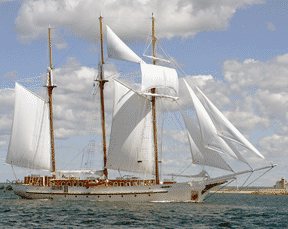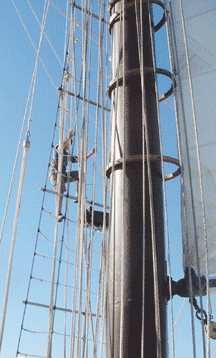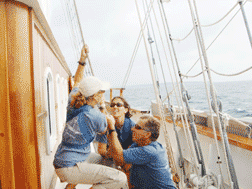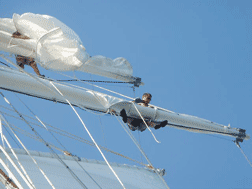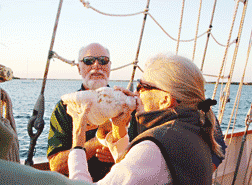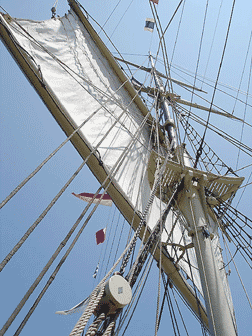 |
|||||||||||
|
|||||||||||
|
|||||||||||
|
Mystic Voyaging Powered by wind and fitted for luxury, this modern-day tall ship is a steel-hulled hybridby Maureen MillerBillowing white sails upon towering masts: Tall ships awaken the poet, artist or dreamer in each of us. Seeped in tradition, these behemoths call us like sirens to sail into the past. When the Mystic sails into your ken, she’ll set you dreaming — and wondering. At 170 feet from bow to stern, she’s half as long as a football field. With rigging towering 107 feet into the sky, she rises like cathedral spires. She’s a new ship on the horizon, a 2007 hybrid of her traditional class, an authentic sailboat combining modern comforts with historic looks. When I first saw the schooner Mystic in Panama City, Florida, on a blustery day in mid-April, she was a construction site with two-inch metal studs sticking up where the teak deck would be going down. Piles of Spanish cedar for the woodwork were stored in her dining area. A makeshift desk, microwave and tools filled what would become the lounge. Below, you had to imagine the galley and cabins being fitted into the ribs of her steel hull. How could she be ready for delivery — around Florida and up the East Coast to Connecticut — in less than a month? Back then, I had yet to learn the tenacity, energy and perseverance of her designer, builder and owner, 38-year-old Amy Blumberg.
Amy’s Dream BoatBlumberg and Mystic both kept their date. By June, they were sailing with passengers. I was one, together with 33 boating enthusiasts, all friends from the Hope Town Sailing Club in the Bahamas. We had gathered from around the States for a reunion and to check out this ship built by the daughter of two of our club members. For five days, we explored the waters and small islands off the coasts of Connecticut, Rhode Island and Massachusetts. In the close quarters aboard ship, I got to know my friends better, as well as Blumberg and the Mystic. “Why did you build this ship?” I wondered. “Boredom,” Blumberg said. A child of passionate sailors, Blumberg grew up on boats in Wisconsin’s Great Lakes country. “Amy worked on cruise ships around Sturgeon Bay,” says stepfather George Holloway. “She got her first captain’s license when she was about 17, graduated as a mythology major from the University of Wisconsin and went to sea.” Blumberg dreamed big. She wanted to build her own cruise ship. To build the resume to attract financing, she became a schooner brat, sailing schooners from coast to coast. Seven years ago Blumberg bought Voyager Cruises in Mystic, Conn., from her retiring boss. Along with the business, she inherited the 81-foot Argia, a replica of a 19th century coastal trading schooner that carries 49 passengers on day trips. Captaining, staffing and maintaining the Argia, as well as administering Voyager Cruises, didn’t keep Blumberg busy enough. Two years ago, she dusted off her dreams, secured financing and designed, built and launched the Mystic. “The Mystic is named after her summer home port in Connecticut,” Blumberg says. “But like many cruisers, she’ll follow the winds and the tides.” And the weather. In summer, the Mystic cruises the New England coast. This fall she’s cruising the Chesapeake Bay out of Baltimore. When cold weather approaches, she’ll head south, to sail the gin-clear waters of the Bahamas. Come spring, she’ll return to the Chesapeake, and in summer, she’ll return to New England. Topside, Tradition ReignsTopside the Mystic seems a traditional schooner. Her rigging is awesome, with three towering masts and 17 miles of lines to set her 14 sails. No winches or power systems help raise these sails. Sails are set as they were until this century, by the strength of her crew, with a little help from her passengers if they’re so inclined.
“I’ve been working out in the gym again,” said passenger Rick Judge from Delaware Beach after hauling up the mainsail alongside two sailors. You can see by the sweat on his brow in the cool New England breeze that he’s not kidding. Sailing this ship is a workout. Tasks are many and varied, so Blumberg and her crew need not fear boredom. With 34 passengers on board, crew loads baggage, keeps house, serves meals and runs Mystic’s 17-foot launch back and forth to shore. What they like best is the hardest work: raising anchor, hoisting sails, coiling lines, maintaining the rigging. “I love the style of her rig,” says Leslie Blumberg, Amy’s sister and Mystic’s relief captain. “It’s a great place for sailors to play.” “The rigging is my favorite part on the whole ship,” says Katie Fitzgerald, who thinks nothing of furling the square mizzens while hanging 100 feet aloft in a 20-knot breeze. Grandniece of Annapolitans and former Fawcett Boat Supply owners Dick and Louise Hutchings and granddaughter of Bill Simmons, Fitzgerald grew up sailing the Bay out of Annapolis. This experience qualified her for a spot on the Tole Mour, one of two ships on which Blumberg based Mystic’s design. But after graduating from college, Fitzgerald figured it was time to get a real job and ended up at a desk in the Big Apple. “It wasn’t long before I tired of being indoors all day and the hustle and bustle of the city,” she says. “I realized I really wanted to get back to the sea.” Persistence paid off; a resume and four follow-up calls got her a berth on the Mystic. Passenger Willy Heron, from the Boston area, had dreamed of climbing into the rigging of a tall ship. So one foggy morning, while we were at anchor, first mate JoAnna Josie helped him make a slow, steady climb aloft. “The first step was the hardest, he reported. “There wasn’t much of a view with the fog, but it was a great feeling.” “Normally, the view up there is incredible,” says crewmember Erin Ryding, who knows the rigging intimately, having helped assemble much of it. Ryding is as fearless and agile as a monkey when scampering aloft. Yet she’s only been sailing “about a year.” Ryding learned sailing while working, in period costume, on Washington State’s tall ship ambassador, Lady Washington. But she’s been climbing since childhood. Ryding grew up in a log cabin behind a forest on Vancouver Island in British Columbia, with plenty of walls, rocks, trees and boats. Concessions to modern days above deck are the lounge and dining areas. During our cruise, the lounge, with its 15 black leather easy chairs, carpeting, skylights and plenty of windows, served as a reading room and lecture hall by day. In the evening, the bar became the focal point for Hope Town-style happy hours, called stand-ups. “My dad, Paul Blumberg, built the bar and the tables in the dining room,” says Amy. “He did most all of the woodwork on the boat. When he finished the tables, he sent them to Connecticut to be stored. I never saw them until we arrived in June.” Much of the woodwork is Spanish cedar. Seven hand-turned dining tables are topped with intricate olive-ash veneer. During cruises, they double for card and game tables.
Modern Conveniences Add ComfortBelow decks, you see the Mystic’s modern side: no steamy 18th century cramped, smelly quarters here. “The Mystic’s got great systems,” says relief captain Leslie: “a nice engine, good plumbing, air conditioning and a nice combination of fore and aft cabins.” With 18 staterooms, the schooner can sleep 36 passengers. There are separate quarters for a crew of 12. While not overly spacious, each stateroom has a porthole or skylight allowing daylight into the interior. Couple light with comfortable berths, a small sink, a 110-volt outlet and individually controlled air conditioning, and you can call the quarters cozy. Five flush toilets and four shower rooms complete the quarters. “Mom helped me pick out the colors and linens,” Blumberg says. “And she insisted I put a full-sized washer and drier on-board.” Mom is Sue Holloway, who also holds a captain’s license. Having spent the past 20 winters cruising in the Bahamas, she knows first-hand the dearth of laundry facilities there. Five-Star Cuisine
The food appearing from the ship’s contemporary stainless steel galley is a far cry from old sailors’ staples of hard tack, dried peas and salt pork. “Chef John is the best-loved crew member on this ship,” Holloway says. Chef John Hawkins hails from Richmond, Virginia. Before joining the Mystic, he spent 17 years in the Caribbean, part of the time as chef and manager at Foxy’s Taboo on Jost Van Dyke in the British Virgin Islands. I’d met Hawkins on that blustery April day, his first day onboard the Mystic, when he’d been pressed into carpentry work. “But,” said Hawkins, “cooking’s what I do.” And does it well. Meals are ample and varied. Tempting smells of omelets and homemade muffins entice early risers to the dining room. Lunches consist of homemade soup, salads, prime rib sandwiches or quesadillas to satisfy appetites growing in the fresh sea breezes. At dinner, Hawkins soars. He serves three courses during the casual sit-down meal. The first, an appetizer, is delicately arranged before the dinner bell. An entrée follows, a mahi-mahi sitting on a bed of wild rice, or a slice of au-jus prime rib or lamb with a touch of herbs or Asian seasonings. Vegetarians are always accommodated. And when you think yourself too full to touch another bite, there’s dessert: berry pies, chocolate cakes, cheesecakes and ice cream. “I use fresh foods from the ports we visit,” Hawkins says. Imagine what he’ll concoct with Bay crabs, rockfish and oysters.
21st Century ConcessionsA critical modern amenity on board the Mystic is hydraulic steering. Though it may be a necessity on a ship of her size, it’s not necessarily a favorite of relief captain Leslie, who normally captains the smaller schooner Argia. “It’s hard to feel the ship with this power steering,” she says. “But it can be really useful at times.” Like when sailing up or down the Mystic River or in and out of Baltimore Harbor. “I’m amazed at how difficult it is to come into a harbor in a 170-foot boat,” says Annapolitan Gerri Smith. Smith and husband Skip sail the Bay in their 36-foot Islander, Yellow Bird, from their dock on Spa Creek. The Mystic’s retractable centerboard is useful in harbors, rivers and shallow waters. “I designed her to sail the Mystic River, Chesapeake Bay and Bahamian Islands,” Blumberg says. “With her centerboard down, she draws 18 feet. When it’s up, she only draws nine and a half.” Even with her shallow draft, the Mystic handles the seas well. Her 14 sails are raised and lowered not only to catch the wind but also to add stability. Her gentle rock at anchor quickly induces sleep. “I was impressed with how stable she is,” says former Annapolitan Bob Rogers. Rogers has plenty of insight into the benefits of stable boats, as he and his wife Betty seasonally make the Annapolis/Hope Town cruise in their 42-foot Krogan trawler, Nereid. The ultimate concession to modern times, the Mystic’s single-screw 500- horsepower diesel lugger provides power while docking or additional speed during days with low wind. A Mystical ScheduleIn Chesapeake Bay, the Mystic promises a nice mix of traditional and modern times. “We’ll definitely be doing traditional bar-hopping,” says first mate Josie, as she and Fitzgerald reel off the names of some of the Bay’s more famous boaters’ haunts. Josie, from New Hampshire, has crewed on the Bay schooners Sultana and Virginia. “I got to fire the cannon for the start of the Governor’s Cup Race in 2004,” Josie says. “And I absolutely love the Virginia. I was aboard for her first season.” Josie has also sailed the Caribbean, around Australia, New Zealand and the Cook Islands. With a major in marine biology and land ecology, she’s a dedicated seafaring wanderer. Her motto is Not all who wander will be lost. The Mystic herself will follow tradition by joining some 40 other tall ships in the 18th Annual Great Chesapeake Bay Schooner Race. As the second largest boat in the fleet, the Mystic is sure to stand out. Only Philadelphia’s Gazela is larger — by seven feet. “It’s an event I’m really looking forward to,” says Josie, who anticipates beating former mates aboard the Sultana. The 127-mile race to Save the Bay started at 1pm on October 11 just south of the Bay Bridge and finishes approximately a dozen hours later in Portsmouth, Virginia. The evening before the race, the Mystic strutted her stuff in the Parade of Sail through the Fell’s Point and Baltimore Inner Harbor waterfronts. Returning to modern times, the Mystic sails back up the Bay to Baltimore to carry passengers on two- to five-day Bay cruises to throw cares to the wind, grab a line, pull up anchor and travel where tides and winds dictate. Maureen Miller, wanderer and erstwhile Galesvillian, is in her element aboard boats. Her Bay Weekly stories “Sailing into Poetry” (Vol. xiv, No. 40) and “What’s in a Boat Name” (Vol. xiii, No. 41) help explain why.
|
|||||||||||
|
|||||||||||
|
|
|||||||||||
|
© COPYRIGHT 2007 by New Bay Enterprises, Inc. All rights reserved.
|
|||||||||||

